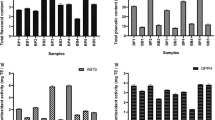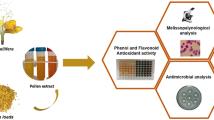Abstract
In this study, three Egyptian bee pollen types from different plant sources, namely maize (Zea mays), clover (Trifolium alexandrinum), and date palm (Phoenix dactylifera), were evaluated as natural antimicrobial agents, antioxidants, and food additives. A methanolic extract of maize bee pollen exhibited the highest antibacterial activity, followed by clover and date palm bee pollen. Staphylococcus aureus and Escherichia coli were the most sensitive, followed by Listeria monocytogenes, Salmonella enteritidis, and Pseudomonas aeruginosa. In ghee, all methanolic extracts, especially that of maize bee pollen, showed high antioxidant activities as radical scavenger substances and as inhibitors of lipid peroxidation. Sensory evaluation of yoghurt supplemented with different bee pollens revealed that maize bee pollen improve texture, increased gel strength, and decreased syneresis and had favorable nutty flavor, while clover and date palm pollen added a sweet taste and bean-like flavor, respectively. These findings establish the potential of Egyptian maize and clover bee pollen as antioxidants, antimicrobial agents, promising natural food supplements, and natural preservatives.
Similar content being viewed by others
References
Manca de Nadra MC, Rodriguez Vaquero MJ. Human health benefits, antimicrobial properties, and the future of phenolic compounds as preservatives in the food industry. pp. 467–485. In: Wine and Health. O’Byrne P (ed). Nova Science Publishers, Inc., Hauppauge, NY, USA (2009)
Morgano MA, Milani RF, Martins MT, Rodrguez-Amaya DB. Determination of water content in Brazilian honey bee-collected pollen by karl fisher titration. Food Control 22: 1604–1608 (2011)
Stanciu OG, Marghitas LA, Dezmirean D. Macro- and oligo-mineral elements from honeybee-collected pollen and beebread harvested from Transylvania (Romania). Bull. Uasvm Anim. Sci. Biotechnol. 66: 1–2 (2009)
González G, Hinojo, MJ, Mateo R, Medina A, Jiménez M. Occurrence of mycotoxin producing fungi in bee pollen. Int. J. Food Microbiol. 105: 1–9 (2005)
Özkalp B, and Özcan MM. Antibacterial activity of pollen and propolis extracts. J. Food Agr. Environ. 8: 17–19 (2010)
Abouda Z, Zerdani I, Kalalou I, Faid M, Ahami MT. The antibacterial activity of Moraccan bee bread and bee-pollen (fresh and dried) against pathogenic bacteria. Res. J. Microbiol. 6: 376–384 (2011)
Stefan B. Pollen: Production, nutrition, and health: A review. Bee product Science. Available from: http://www.bee-hexagon.net. Accessed Jan. 15, 2012.
Wagenlehner FE, Schneider H, Ludwig M, Schnitker J, Brahler E, Weidner WA. Pollen extract (cernilton) in patients with inflammatory chronic prostatitis-chronic pelvic pain syndrome: A multicentre, randomised, prospective, double-blind, placebo-controlled phase 3 study. Europ. Urol. 56: 544–551 (2009)
Morais M, Moreira L, Feás X, Estevinho LM. Honeybee collected pollen from five Portuguese natural parks: palynological origin, phenolic, antioxidant properties and antimicrobial activity. Food Chem. Toxicol. 49: 1096–1101 (2011)
Savadogo A, Quattara CT, Bassole IN, Traore SA. Bacteriocins and lactic acid bacteria. A minireview. African J. Biotechnol. 5: 678–683 (2006)
Mckinley MC. The nutrition and health benefits of yoghurt. Int. J. Dairy Technol. 58: 1–12 (2006)
Riazi A, Ziar H. Effect of honey and starter culture on growth, acidification, sensory properties and bifidobacteria cell counts in fermented skimmed milk. African J. Microbiol. Res. 6: 486–498 (2012)
Mehmood ST, Masud T, Mahmood T, Maqsud S. Effect of different additives from local source on the quality of yoghurt. Pakistan J. Neutr. 7: 695–699 (2008)
White JH. Pollen, Its Collection and Preparation for the Microscope. 2nd ed. Northern Biological Supplies Ltd., and Martlesham Heath, Ipswich, Antony Rowe Ltd., Eastbourne, UK. p. 28 (1999)
Bauer AW, Kirby WM, Sherris JC, Turck, M. Antibiotic susceptibility testing by a standardized single disk method. Am. J. Clin. Pathol. 45: 493–496 (1966)
Patton T, Barrett J, Brennan J, Moran N. Use of a spectrophotometric bioassay for determination of microbial sensitivity to manuka honey. J. Microbiol. Methods 64: 84–95 (2006)
Baron EJ, Peterson LR, Finegold SM. Methods for testing antimicrobial effectiveness. pp. 171–194. In: Diagnostic Microbiology. Mosby Co., St. Louis, MO, USA (1994)
Yu L, Perret J, Haley S. Antioxidant properties of bran extracts from alkorn wheat grown at different locations. J. Agr. Food Chem. 51: 1566–1570. (2003)
AOAC. Official Methods of Analysis of the Association of Official Analytical Chemists. The Association of Official Analytical Chemists. Arlington, VA, USA. p. 1298 (2005)
Human H, Nilson SW. Nutritional contents of fresh, bee-collected and stored pollen of Aloe greatheadu var davyana (Asphodelaceae). Phytochemistry 67: 1486–1492 (2006)
AOAC. Association of Official Analytical Chemists. Official Methods of Analysis. 17th ed. Washington, DC, USA. (2000)
Dave RL, Shah N. Viability of yoghurt probiotic bacteria in yoghurts made from commercial starter cultures. Int. Dairy J. 7: 31–40 (1997)
SPSS. Statistical Package for Social Sciences. SPSS Inc., Chicago, IL, USA. (1999)
Duncan DB. Multiple range and Multiple F test. Biometr. 11: 1–42 (1955)
de Man J, Rogosa M, Sharpe E. A medium for the cultivation of lactobacilli. J. Appl. Bacteriol. 23: 130–135 (1960)
Fennema OR. Principles of food science. pp. 1067–1068. In: Part I. Food Chemistry. Dekker M. (ed). New York, NY, USA, (1976)
Thabet HA. Biochemical studies on some pollen grains. PhD Thesis, Faculty of Agriculture, Cairo University, Cairo, Egypt (2008)
Day S, Beyer R, Mercer A, Ogden S. The nutrient composition of honey bee-collected pollen in Otago, New Zealand. J. Apicul. Res. 29: 138–146 (1976)
Szczêsna, T. Protein content and amino acid composition of beecollected pollen from selected botanical origins. J. Apicul. Sci. 50: 81–90 (2006)
Halliwell B, Gutteridge JC. Free radicals in biology and medicine. 3rd ed. Oxford University, Clarenson Press, UK. pp. 416–494 (1989).
Campos MG, Cunha PA, Navarro MC, Utrilla MP. Free radical scavenger activity of bee pollen. Polyphenols 94: 414–426 (1994)
Suja KP, Abraham T, Thamizh NS, Jayalekshmy A, Arumughan C. Antioxidant efficacy of sesame cake extract in vegetable oil protection. Food Chem. 84: 393–400 (2004)
Almeida-Muradian LB, Pamplona LC, Coimbra S, Barth OM. Chemical composition and botanical evaluation of dried bee pollen pellets. J. Food Compos. Anal. 18: 105–111. (2005)
Graikou K, Kapeta S, Aligiannis N, Sotiroudis G, Chondrogianni N, Gonos E, Chinou I. Chemical analysis of Greek pollen-Antioxidant, antimicrobial and proteasome activation properties. Chem. Cent. J. 5: 33–48 (2011)
Erkmen O, Özcan M. Antibacterial effects of Turkish propolis, pollen and laurel on the spoilage and pathogenic food-related microorganisms. J. Med. Food 11:587–592 (2008)
Loizzo MR, Statti GA, Tundis R, Conforti F, Ando S, Menichini F. Antimicrobial activity and cytotoxicity of Cirsium tenoreanum. Fitoterapia 75: 577–580 (2004)
Hussein MM, Hassan FM, Abdeldaym HH, Salama A, Enab AK, Abd El-Galil AA. Utilization of some plant polysaccharides for improving yoghurt consistency. Ann. Agr. Sci. 56: 97–103 (2011)
Yu-Tang HE, Chang LU, Jian-Hua S. Effects of active components in pollen on fermentation and qualities of yoghurt. J. Food Sci. 29: 58–60 (2008)
Author information
Authors and Affiliations
Corresponding author
Rights and permissions
About this article
Cite this article
Khider, M., Elbanna, K., Mahmoud, A. et al. Egyptian honeybee pollen as antimicrobial, antioxidant agents, and dietary food supplements. Food Sci Biotechnol 22, 1–9 (2013). https://doi.org/10.1007/s10068-013-0238-y
Received:
Revised:
Accepted:
Published:
Issue Date:
DOI: https://doi.org/10.1007/s10068-013-0238-y




